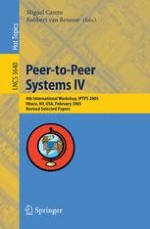2005 | Buch
Peer-to-Peer Systems IV
4th International Workshop, IPTPS 2005, Ithaca, NY, USA, February 24-25, 2005. Revised Selected Papers
herausgegeben von: Miguel Castro, Robbert van Renesse
Verlag: Springer Berlin Heidelberg
Buchreihe : Lecture Notes in Computer Science
